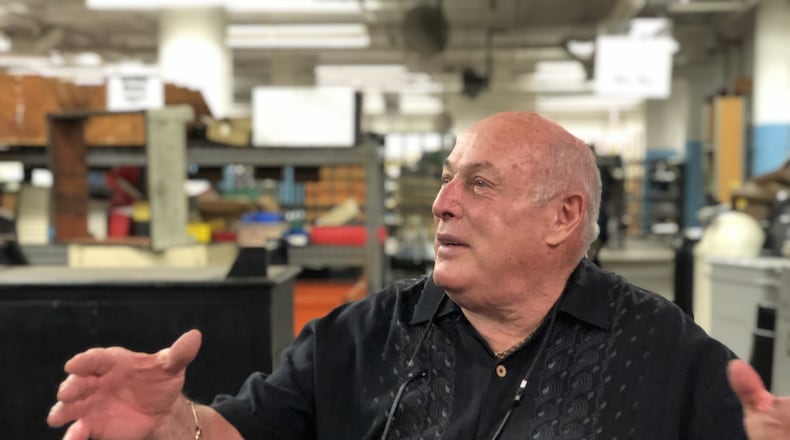JUST IN: Well-known downtown developer’s plan for Mendelson properties could reach $100M
Crawford Hoying says its investment in the Mendelsons buildings could surpass $100 million, which is more than the first phase of the Dayton Arcade. Crawford Hoying already has invested about $120 million downtown in the Water Street District.
The purchase and redevelopment of the Mendelsons building represents the culmination of decades of work transforming today’s Webster Street District from a blue-collar industrial area to “vibrant mixed-use” locale, said John Gower, place-making engineer for the city of Dayton and CityWide Development.
It began nearly 20 years ago, if not earlier, with the creation of the home of the Dayton Dragons, Fifth Third Field, the nearly simultaneous creation of the Riverscape riverfront setting, then the Cannery loft apartments, followed by the opening of the Second Street Market.
“There were four really big initiatives that anchored these beginnings in the late 90s, early 2000s,” Gower said.
Crawford Hoying’s project to renovate and reuse the Mendelsons building and an adjacent warehouse and parking lot will be bigger than the Dayton Arcade, said Sandy Mendelson, 76, the long-time businessman who is retiring.
The 340 E. First St. building is larger than the arcade’s nine buildings, which have more than 420,000 square feet of space, as well as the 30-story Stratacache Tower complex, with about 500,000 square feet.
The building at 340 E. First St. is unlike anything else downtown, offering great views, concrete floors, 13-foot ceilings, lots of windows, working fire and electrical systems, three freight elevators and the oldest passenger elevator in Ohio, Mendelson said.
Mendelson said he’s spent millions of dollars keeping up and improving the property since he acquired it nearly four decades ago.
Mendelson invested in Webster Station when there was little demand for buildings in the area.
He and a partner bought what would become the Delco Lofts, next to the ballpark, along with the massive liquidation outlet store for $1.5 million in 1981.
City planners and local economic-development officials have long wanted to see Webster Station again become a thriving mixed-use neighborhood, as it was in 1920s.
RELATED: From pickles to papers, How Sandy Mendelson built his business
Over the decades, the neighborhood’s housing disappeared and it also lost amenities and businesses. By the 1990s, the area primarily was home to light industry, warehousing, wholesaling and empty buildings.
But a rebirth was predicted around the turn of the century because of the $23 million investment to create the Dragons ballpark, called Fifth Third Field.
Mendelson also played a role in that project: He owned the land the ballpark was built on, along with Dayton Supply and Tool Co.
The ballpark and RiverScape projects led to renewed interest in the area.
Crawford Hoying arrived in Dayton and partnered with Woodard Development, creating the Water Street District mixed-used area, giving the private sector even greater traction in that part of downtown, Gower said.
A former Delco factory was transformed into Delco Lofts and the Centerfield Flats followed quickly followed, rising to the east of Fifth Third Field. Centerfield is already leasing its apartments.
The upshot is that Crawford Hoying is ready for what Gower called “the big leap.”
“I actually think the building is really a great candidate for adaptive reuse because of how it was designed and built,” he said.
Crawford Hoying says its project could get under way in late spring and is likely to take two to three years to build out.
The Mendelsons building was constructed in the early 20th century and has had about 30 additions in the decades since.
RELATED: BUSINESS SPOTLIGHT: Sandy Mendelson not ready to stop dealing
The result is a building shaped like a “rectangular donut” — filling up an entire city block with an inner courtyard or “light well” in the middle.
The building is easily convertible — to housing, to hotel uses, to offices, to more, Gower said.
“I think part of the key to all of this is, how do you activate the street level with these urban lifestyle uses that further creates the connectivity between the ball park and Oregon” District, he said.
Webster Station is the hottest section of downtown for new housing, offices and destinations.
Water Street Flats has about 269 apartments along the river, and the Water Street office building features Basil's on Market restaurant, PNC Bank, Snap Fitness and other businesses. The office building opened in 2015, and the apartments after that.
Next door is the the 98-room Fairfield Inn & Suites, which opened in October as downtown’s first new hotel in decades.
The $25 million Delco Lofts project overlooking Dragons stadium created 133 new apartments, which opened in mid-2017.
RELATED: See where millions have been spent to improve downtown Dayton
The Centerfield Flats is still under construction but will offer 112 units. Old commercial buildings have been turned into new offices, like the Avante-Garde, and new amenities like the Steam Plant event center. Charles Simms Development also built new townhomes nearby, and breweries and tap rooms have moved into the area.
Since closing in 1991, the Dayton Arcade arguably has been the most talked about and closely watched downtown property.
But the Mendelsons building isn’t too far behind, partly because of rumors swirling about for years of potential deals.
Mendelson said he has had probably 10 buyers show real interest in his buildings in recent years.
He estimates he’s spent $50,000 on attorney fees in the last eight or so years trying to vet potential buyers, write up contracts and prepare legal documents for deals that fell through.
The sale to Crawford Hoying raises questions about what’s next for Mendelsons, and Sandy Mendelson doesn’t have all the answers.
He’s going to retire, but the family still owns the Mendelsons name and his daughter and son will have to decide whether to have a going-out-of-business sale or relocate.
There’s nothing quite like Mendelson’s anywhere else in the world, which is why customers come from all over to shop at the liquidation outlet, Mendelson said.
MORE: Mendelson’s sale sets stage for $100M downtown project
Mendelsons is a surplus outlet with a wide range of products — some very eclectic, some Mendelson calls “junk.” The store has a F-16 simulator, an old medic and rescue vehicle, retro couches and millions of industrial, mechanical, electrical and computer parts, components and pieces.
The store sells body bags to coroners. It sells old salon chairs, toys and industrial equipment.
A couple of years ago, Mendelson bought a dozen semi-trailers worth of outdated books — maybe a million items. He said they were a big hit and sold fast.
Mendelson estimates his business generates several million dollars in revenue each year, which includes sales related to the 17,000 items advertised each day on eBay.
Mendelson owns a 100,000-square-foot warehouse at East Third and Keowee streets. He says it’s possible the business will move there. The family also owns Top of the Market, a popular banquet and events center in Webster Station.
Sandy Gudorf, president of the Downtown Dayton Partnership, called the sale to Crawford Hoying “incredible news.”
“Of course, Mendelson’s was an iconic destination,” she said. “But everyone knew it was a matter of time.”
Downtown advocates welcome Crawford Hoying’s continued involvement.
“That is huge,” Gudorf said. “They (Crawford Hoying and development partner Jason Woodard) have already invested more $100 million in their Water Street development.
“This building just caps it all.”




